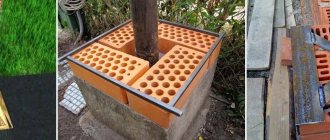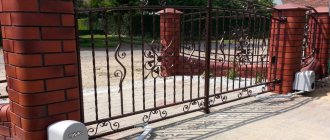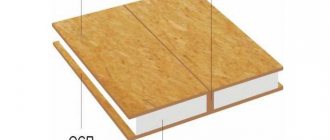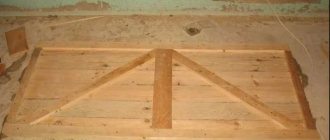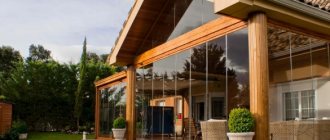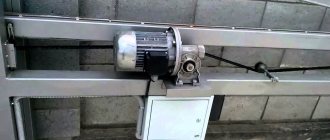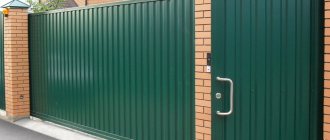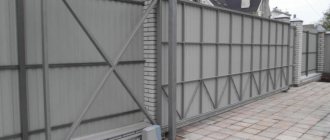Do-it-yourself swing gates are one of the most common types of gates, which are chosen when improving small private plots and large private areas. The choice of these particular gates is justified by the fact that they are easy to install and reliable during active use. By installing such gates on your site, you can not only protect your property, but also save money. Below we will look at the features of such structures and figure out how to install them yourself.
Advantages and disadvantages
Like every design, such gates have their own advantages and disadvantages; we will consider them in more detail below:
- Advantages:
- relatively low cost, which will be a pleasant bonus to the installed gates;
- ease of installation;
- long service life of the installed structure;
- installation can be done on your own;
- installation can be done with your own design modifications;
- if there are no restrictions in volume, then accordingly there will be no restrictions on passing transport;
- you have the opportunity to choose on your own what material you will make the structure from, respectively, from suitable options.
- Flaws:
- for durable installation, it will be necessary to bury the pillars quite deeply, and this is not always easy to do with your own hands;
- concreting these pillars takes a lot of time, and if concreted incorrectly, the pillars may warp over time;
- a very large space will be required to install such a barrier;
- it is unsafe to use such structures in strong winds, because it will be almost impossible to control the doors;
- When installing an electric drive, you must purchase several wires to close/open the gate, which will increase the cost of your purchase.
As you can see, the advantages of such structures outweigh the disadvantages, and if you live in a region where strong gusty winds are not the norm, feel free to proceed with the installation of swing gates on your site.
Popular materials for making gates
Among the most common materials for gates, the first place is given to metal , the second to wood .
But, if we are talking about garage doors, then definitely choose metal (corrugated sheeting). Advantages and disadvantages of different gate materials
| Material | Advantages | Flaws |
| Corrugated sheet |
|
|
| Tree |
|
|
Types of metal structures
Before you start assembling your new gate, it will be important to decide on its design. The choice should be made taking into account a number of features, the main one of which is the frequency of operation. Using metal you can make various variations, we will consider each of them separately.
Single leaf
Iron gates of this type are not very popular. This is a solid canvas that is not particularly practical to use. In order for them to work perfectly, it is important to reliably strengthen the supports; a lot of money will have to be spent on this. When you decide to install the structure in a garage, take care of constructing a powerful and reliable metal frame, and also do not forget to attach the hinges. The disadvantages include the need for space for the sash to function.
Bivalve
The most popular and practical to use. You can install them yourself on your site without any difficulties. The structure is made of 2 canvases that are the same in size, therefore, you will need to make a frame from two frames and cover them with sheet material.
Double doors with gate
They are very practical for daily use. They are manufactured like the previous design, the only difference is the presence of a special gate on one leaf. If you plan to install this type of structure in a garage, you must choose a mortise type of gate.
Frame making
First, you need to calculate the dimensions, correctly draw a drawing with the placement of the smallest parts, make several sketches from different angles, and only after accurately calculating the amount of required materials and total costs, start assembling the frame.
When determining the height of the future gate, it is important to leave gaps below the ground level of 5 to 10 cm. If tiles or asphalt are laid on the site, then the gaps can be reduced to 5 cm. If there is no covering (if grass grows there), the gaps should be left larger.
The frame can be made of wood or metal. Due to their limited service life, wooden elements are most often used as decoration or for a temporary fence.
For a permanent and durable fence, it is better to use metal. The frame is assembled from it using welding.
Diagram of a frame for a gate made of a profile pipe
To obtain a frame, you need to prepare profile pipes in the following quantities and sizes:
- 22 m of corrugated pipe with a cross section of 60*40 mm will be needed for the main parts and jumpers. The elements will be welded to the pillars and are responsible for holding the entire structure.
- 15 m of corrugated pipe with a cross section of 40*20 mm - to strengthen the frame. The sash trim is attached to them.
The thickness of the metal should be at least 1.5–2 mm. For beginners in welding, it is better to take sheets with walls of 3 mm.
is when purchasing frame material .
For large-sized products, we recommend taking into account the following points:
- With a leaf weight of up to 150 kg, a pipe with a cross-section of 80*80 mm and a thickness of 4 mm is sufficient.
- In the range from 150 to 300 kg, a reinforced version is taken with a section of 100 * 100 mm, with a wall thickness of 5 mm.
- For malleable and other heavy products weighing over 300 kg, you need to take iron pipes with a cross-section of 140 * 140 mm, 5 mm thick.
The correct procedure for assembling the frame is described above in the article about swing gates made of corrugated sheets.
Together with the gate
If the diagram indicates that the gate will have to be built into the gate, then it is necessary to ensure sufficient reinforcement of the frame. Since installation in one section significantly makes the structure heavier. This factor is also taken into account when choosing loops.
Without a gate
It is much more practical to install the door separately. This is considered a classic installation option.
The gate is mounted both next to the gate and at a significant distance from it (at the owners’ choice). The load is distributed evenly.
Types of sliding structures
You can find a wide variety on the market: steel, aluminum, with or without insulation, controlled by an electric drive or a spring system. The devices are suitable for rooms where it is necessary to make optimal use of the space under the ceiling (for example, if there is a low lintel or other elements that limit installation options).
Types of products:
- console;
- hanging;
- rail
Their advantages:
- Ease of use;
- strength and safety;
- multifunctionality;
- installation does not require much space;
- available in various designs;
- possibility of installing automation and anti-theft system.
Hanging gates
Advantages:
- space saving;
- easy care;
- strength and weather resistance.
Sliding rail gates
In this design, the canvas moves on rollers along a rail, which is installed in the foundation.
Advantages of this design:
- easy installation;
- relatively low cost;
- resistance to weather conditions and shocks;
- long service life;
- Easy control both automatically and manually.
The disadvantage of these designs is regular cleaning, because... Dirt, leaves, sand, etc. constantly accumulate in the rails, and in winter snow and ice can immobilize the structure. To prevent this process, a heating cable is placed in the device.
Console gates
This type is used for fencing various courtyard areas and is well suited for warehouses and manufacturing plants where there is heavy vehicle traffic. Cantilever products are made from quality materials and are the preferred choice because... characterized by aesthetic appeal, high functionality, available in various models.
Galvanized profiles are used in production. Their sizes may vary depending on customer requirements. The special coating provides long-term protection from adverse weather and mechanical influences. The gate can interface with an automated system, allowing the owner to open and close it easily. The most commonly used automation is from leading European brands.
Advantages:
- durability and practicality;
- simple and easy care (they do not need to be cleared of snow and dirt);
- installation requires little space;
- installation of cantilever structures is simple and convenient;
- the height of the structures can be adjusted depending on the unevenness on the ground;
- Despite the complex design, products of this type open easily and silently.
Even if the gate is exposed to a number of unfavorable external factors, it does not wear out over a long period of use.
Rolling gates
Advantages:
- They are cheaper than sectional and others.
- Compactness. They take up little space.
- Easy to install (the design contains a minimum number of components, and installation takes a minimum of time and effort).
- Easy transportation. Disassembled products can be transported even on the roof of a car.
At the request of the client, structures can be manufactured with special anti-burglary protection. Bolt latches installed in the bottom armor strip prevent the gate from opening. Additionally, in order to limit access to internal objects, a card or code keypad can be made. The control signal call can be encrypted with up to a 9-digit code.
Types of automatic gates
Electric drives attached to structures allow remote control. The owner of the house has the opportunity to open the gate without going outside, which is especially convenient during bad weather.
Main types of gates:
- sectional;
- lift-and-swivel;
- recoil;
- swing
Automatic gates are convenient, functional and practical. Modern drives guarantee safety of use and protect the mechanism of structures. Depending on the purpose, size, weight and installation conditions, the gate can be driven by one of several types of electric drives:
- lateral, three-phase;
- side tubular single-phase;
- single-phase central;
- other.
How to cover sliding gates
Do you want to cover your sliding gates yourself? There are two options:
- Buy the necessary tools, materials and components and do everything yourself (which is extremely difficult).
- Order the production and installation of sliding gates without filling the frame at a competitive price in Moscow.
Next, we will talk about how to cover the gates on the street and show interesting design solutions.
Note! Filling the frame yourself will not require significant time investment. Sheathing involves only fastening selected materials using screws or welding.
Covering sliding gates with corrugated sheets
Corrugated sheeting is the most popular material for cladding sliding gates. Galvanized steel sheets treated with high-quality paints combine:
- low cost;
- wide choice of color and design solutions;
- light weight;
- resistance to adverse weather conditions and temperature changes;
- long service life.
Photo No. 12: sliding gates covered with corrugated sheets
Covering sliding gates with European picket fences
Covering sliding gates with European picket fences will help maintain the area's airflow. The structure will not experience serious wind loads.
Photo No. 13: sliding gates lined with Euro picket fence
Covering sliding gates with wood
Wood is an excellent choice for those who want to combine modern technology and traditional natural materials. This option for filling the frame has one important drawback. Gates lined with wood will have to be regularly treated with protective compounds.
Photo No. 14: sliding gates covered with wood
Covering sliding gates with sandwich panels
Covering sliding gates with sandwich panels is popular when decorating street and sectional garage structures in the same style. To fill the frame you will need a welding machine. The result is a rigid structure. Sandwich panel fabric does not make loud sounds when moving.
Photo No. 15: sliding gates covered with sandwich panels

